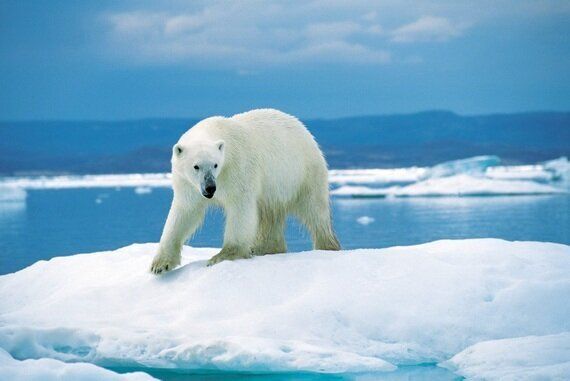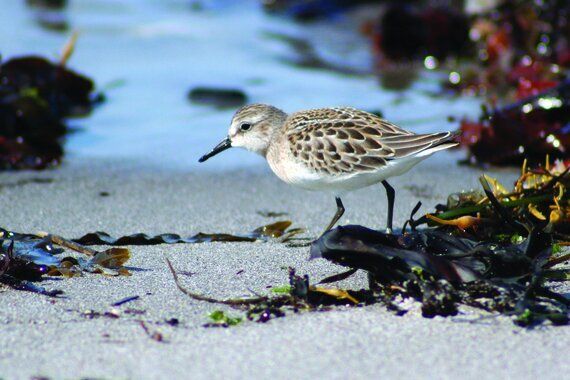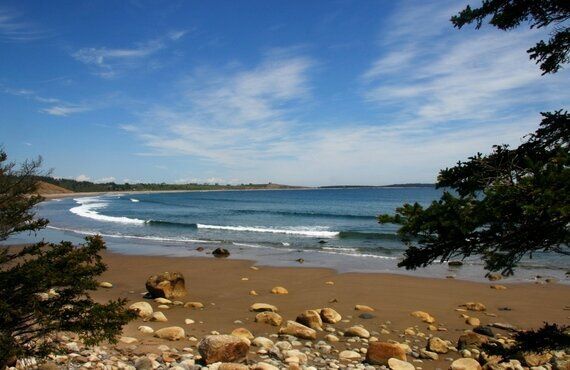
Polar bear in Wager Bay, Nunavut (Photo: Wikimedia Commons)
Oceans and coasts are a key part of Canada's environment, economy and identity, and yet most of us are unaware of how they are protected, and why conserving them is critical.
Precious resources rich in life
Salt water touches every Canadian province and territory, with the exception of Alberta and Saskatchewan. Canada's marine territorial waters measure 5.75 million square kilometres, equivalent to the combined area of India and Greenland. Collectively, Canada's coasts of the Atlantic, Pacific and Arctic Oceans are more than 243,000 kilometres in length -- the longest of any country in the world.
Our oceans have a climatic influence that reaches far inland, and many species that depend on our oceans and coasts ebb and flow into every part of Canada. Fishes migrate for hundreds of kilometres inland to spawn, rear their young or overwinter. From Pacific salmon in the west, to striped bass and blueback herring in the Atlantic, to char in Arctic waters, fishes link the food chains of oceans with freshwater rivers and lakes.
More than half of the world's population of semipalmated sandpipers stop at the Nature Conservancy of Canada's (NCC's) Johnson's Mills property in the fall along the coast of the Bay of Fundy in New Brunswick, but these same birds migrate through the prairies in the spring en route to their Arctic nesting grounds. Even our common loon transforms from a summer bird of our northern lakes, to a coastal bird feeding in nearshore waters of the Atlantic and Pacific oceans when autumn comes.

Semipalmaed sandpiper (Photo: June Swift)
Canada's marine waters are rich in life. They support more than 15 million seabirds and three-quarters of the world's narwhal population. They also harbour species that are becoming rare in Canada and throughout their global range. Canada currently has more than 100 marine mammals, saltwater fishes and sea turtle species that are nationally at risk.
The race to conserve marine areas
The conservation of our marine regions has long been neglected compared to Canada's land-based habitats. Perhaps it was the myth that oceans were endless or not understanding the importance and benefits of marine conservation. Most of Canada's marine protected areas were only created in the 1960s, then from 2000 to the present. While Canada has protected close to 11 per cent of our lands and inland waters, less than one per cent of our oceans have been protected.
Today we recognize that oceans and coasts are a critical part of our collective national ecology. What was once seen as a limitless marine resource is starting to appear more and more fragile in our rapidly changing world. Canada, as a signatory to the Convention on Biodiversity, has committed to protecting 10 per cent of our oceans and coasts by 2020. To date, our collective efforts to protect marine areas have conserved some important sites, but with a total area of 51,000 square kilometres, or less than one per cent of our marine territory, there will need to be some significant actions to meet our target in the next three years.
Marine protected areas are created and administered by three federal agencies in Canada: Parks Canada, Canadian Wildlife Service and Department of Fisheries and Oceans. These protected areas are scattered throughout our oceans and is growing. Recently, two new sites were announced. Anguniaqvia niqiqyuam, near the community of Paulatuk in the Northwest Territories, protects arctic char, ringed and bearded seals, polar bears and seabirds. Hecate Strait protects fragile and globally rare glass sponge reefs off the coast of B.C. that are 9,000 years old.
The role of provincial governments and private land trusts
Provincial governments and private conservation organizations such as NCC also play a role in protecting our oceans. More than 10,000 square kilometres of ocean are protected by provincial agencies. These are mostly nearshore waters and are associated with coastal protected areas, such as the Pointe Au Tonnerre-Île à Paul Waterfowl Gathering Area in Quebec and Broughton Archipelago Marine Park in BC.

Gaff beach, NS (Photo: The Nature Conservancy of Canada)
NCC is also playing an important role in protecting coastal and marine areas, including more than 200 projects on Canada's coasts that are protecting important salt marshes, dunes, beaches and rocky coasts.
The lines between coastal waters and watersheds are blurry. Many NCC projects are helping to maintain coastal water quality and habitat for migratory fishes by protecting rivers and watersheds.
A global leadership opportunity
The conservation of oceans and coasts impacts all Canadians. As stewards of the world's longest coastline, we have an opportunity to show global leadership in marine conservation, and ensure that the richness and abundance of marine habitats and species are protected for our children and grandchildren.
This post originally appeared on the Nature Conservancy of Canada's blog,Land Lines.
Follow HuffPost Canada Blogs on Facebook
Also on HuffPost: